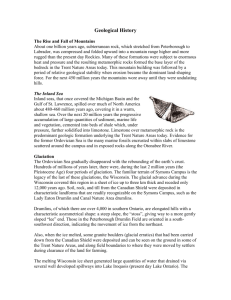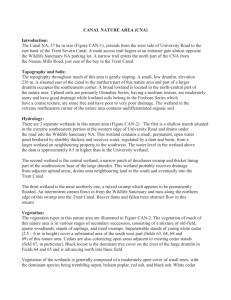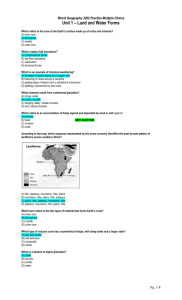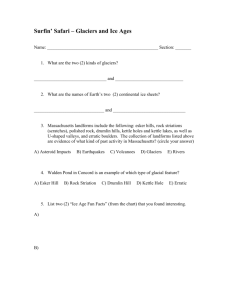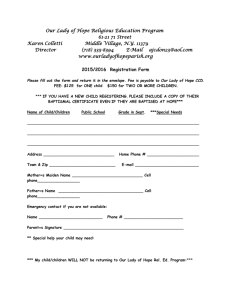lady eaton drumlin nature area (ledna)
advertisement
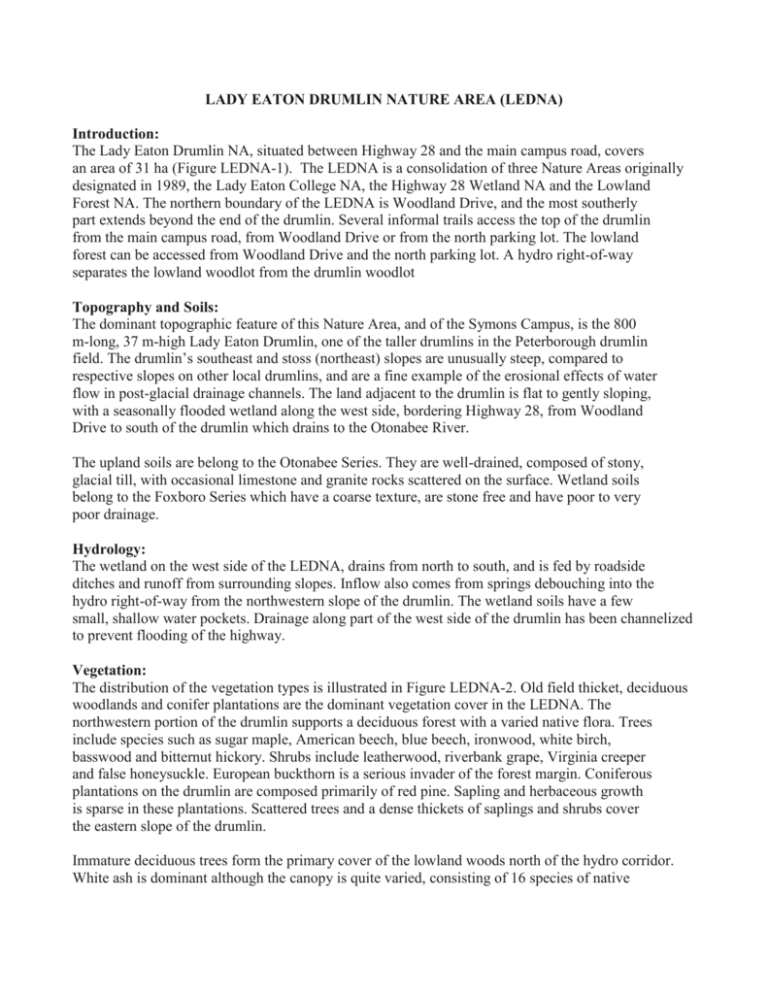
LADY EATON DRUMLIN NATURE AREA (LEDNA) Introduction: The Lady Eaton Drumlin NA, situated between Highway 28 and the main campus road, covers an area of 31 ha (Figure LEDNA-1). The LEDNA is a consolidation of three Nature Areas originally designated in 1989, the Lady Eaton College NA, the Highway 28 Wetland NA and the Lowland Forest NA. The northern boundary of the LEDNA is Woodland Drive, and the most southerly part extends beyond the end of the drumlin. Several informal trails access the top of the drumlin from the main campus road, from Woodland Drive or from the north parking lot. The lowland forest can be accessed from Woodland Drive and the north parking lot. A hydro right-of-way separates the lowland woodlot from the drumlin woodlot Topography and Soils: The dominant topographic feature of this Nature Area, and of the Symons Campus, is the 800 m-long, 37 m-high Lady Eaton Drumlin, one of the taller drumlins in the Peterborough drumlin field. The drumlin’s southeast and stoss (northeast) slopes are unusually steep, compared to respective slopes on other local drumlins, and are a fine example of the erosional effects of water flow in post-glacial drainage channels. The land adjacent to the drumlin is flat to gently sloping, with a seasonally flooded wetland along the west side, bordering Highway 28, from Woodland Drive to south of the drumlin which drains to the Otonabee River. The upland soils are belong to the Otonabee Series. They are well-drained, composed of stony, glacial till, with occasional limestone and granite rocks scattered on the surface. Wetland soils belong to the Foxboro Series which have a coarse texture, are stone free and have poor to very poor drainage. Hydrology: The wetland on the west side of the LEDNA, drains from north to south, and is fed by roadside ditches and runoff from surrounding slopes. Inflow also comes from springs debouching into the hydro right-of-way from the northwestern slope of the drumlin. The wetland soils have a few small, shallow water pockets. Drainage along part of the west side of the drumlin has been channelized to prevent flooding of the highway. Vegetation: The distribution of the vegetation types is illustrated in Figure LEDNA-2. Old field thicket, deciduous woodlands and conifer plantations are the dominant vegetation cover in the LEDNA. The northwestern portion of the drumlin supports a deciduous forest with a varied native flora. Trees include species such as sugar maple, American beech, blue beech, ironwood, white birch, basswood and bitternut hickory. Shrubs include leatherwood, riverbank grape, Virginia creeper and false honeysuckle. European buckthorn is a serious invader of the forest margin. Coniferous plantations on the drumlin are composed primarily of red pine. Sapling and herbaceous growth is sparse in these plantations. Scattered trees and a dense thickets of saplings and shrubs cover the eastern slope of the drumlin. Immature deciduous trees form the primary cover of the lowland woods north of the hydro corridor. White ash is dominant although the canopy is quite varied, consisting of 16 species of native trees, including butternut. The spring herbaceous vegetation is low in species composition but does include wild ginger, wild leek, bellwort, columbine and toothwort. The seasonally flooded wetland vegetation consists mainly of open cattail stands and sparsely wooded deciduous wetland. At the base of the drumlin along the wetland margin may be found species typical of marsh meadows and wet woods (e.g. Joe-pye-weed, sensitive fern, and naked mitrewort). The wetland next to the south end of the drumlin supports shrubs such as nannyberry, shrubby willow and dogwood. Wildlife: Birds observed in forested areas include woodland-nesting species, such as the ovenbird and redeyed vireo as well as other species such as northern cardinal, blue jay and white-breasted nuthatch. Red squirrels in the pine plantation attract raptors. The wetland provides nesting habitat for red-winged blackbirds and common yellowthroats. A barred owl and a common yellowthroat were noted in the area during a Christmas bird count. Western chorus frogs breed in the wetland shallow marsh community. Flying squirrels have been observed in the deciduous woods on the western slope of the drumlin. Evidence of white-tailed deer in the hydro corridor and wetlands has been observed. The four Nature Areas, LEDNA, Highway 28 Woods NA , Total Loss Farm NA and Lock 22 NA, in the northern part of the campus and on the west bank of the Otonabee River, while being separated from one another by Highway 28 and Woodland Drive, form essentially contiguous habitats for birds and mammals. Historical Features: The most obvious cultural feature on the southern part of the Lady Eaton Drumlin is the red pine plantation, which was planted in 1952 by the Kiwanis Club. On the north-eastern edge of the drumlin facilities were provided in the 1930s for ski jumping in the 1930s. In the 1960s, on the north slope, a ski-tow was constructed for downhill skiing ut this was abandoned in the 1970s for safety reasons. A hydro corridor, with two electrical transmission lines, runs across the northern slope of the drumlin and through the wetland Adjacent to highway 28. Scars on maple trees indicate that sap for maple syrup production was once collected. The stone piles on the drumlin summit attest to clearance for agricultural use and the depauperate herbaceous flora in the forest is indicative of grazing by farm animals. Significant Features: The drumlin is a distinctive landmark that provides magnificent panoramic views, to the north and south-east, now partly obscured by sumach and European buckthorn. The eastern slope is an attractive backdrop, particularly in the Fall, to Lady Eaton College, and is a major scenic asset on the Symons Campus. The spring wildflower display in the deciduous forest is the best of any forest on campus. The lowland woods, with their rich moist soils, contain a large number of trees species, including uncommon species such as butternut. Most other deciduous woods on the Symons campus occur on drier uplands (e.g. South Drumlin NA and Highway 28 Woods NA). Land Use: Teaching and Research Classes in Biology, Environmental and Resource Studies and Geography use this Nature Area for field studies and research. Recreational Use Several informal trails on the Lady Eaton Drumlin are used by walkers and joggers as well as for fitness training by students participating in team sports. Bicycle riders traveling at high speed are a hazard to walkers. While these trails have become narrowed by growth of European buckthorn and sumach and are severely eroded in places, sections of trails never-the-less great potential as accessible nature/walking trails. In 1999 the NAC, in recognition of the recreational, interpretation potential and the need for undergraduate classes to have use of a safe nature trail to the woodlot on the drumlin summit, approved a proposal for its construction. The nature trail was included as a “Working for Wilderness” project in 2000 by the Federation of Ontario Naturalists (FON) and the British Trust for Conservation Volunteers (BTCV). Subsequently, 10 UK volunteers, 4 FON and local created the trail in August of that year and also installed 4 benches at panoramic viewpoints along the drumlin summit that overlook the Otonabee River (Figure LEDNA-4). The new trail, which can can be accessed up the centre part of the east side of the drumlin from the Lady Eaton College Parking Lot, runs in a north direction along the drumlin crest while passing through part of the pine plantation and forest before descending the north slope to the North Parking Lot. A loop trail from the main trail, circles through the forest back to the trail which descends the north slope. An extension to the trail for ascending the south end of the drumlin was created in summer 2002. The north slope of the drumlin was once an excellent site for family and community tobogganing during the 1970s and early 1980s until shrubs became established. Adjacent Land Use: The wetland, comprising the western part of the LEDNA, is bounded by Highway 28 (29) and across the road is the Highway 28 Woods NA. Beyond the east and south boundaries, at the base of the Lady Eaton drumlin, is the campus core. The southern boundary is a continuation of the wetland running down the east side of Highway 28. The northern boundary is Woodland Drive and Adjacent to this road is the Lock 22 NA. Ecological Integrity: There is concern that: • European buckthorn has invaded the old field community on the east drumlin slope, the drumlin summit, the pine plantation and woodlots where light conditions are favourable. • the pine and spruce plantations on the drumlin have not been evaluated by a forester and about the amount of European buckthorn growing beneath the pine trees. • tapping may be detrimental to the of mature sugar maple trees. Figure LEDNA-1: Contour Map of the Lady Eaton Drumlin Nature Area, Symons Campus, Trent University, Peterborough, Ontario. Figure LEDNA-2: Vegetation Types in the Lady Eaton Drumlin Nature Area, Symons Campus, Trent University, Peterborough, Ontario. Figure LEDNA-3: Vegetation Communities in the Lady Eaton Drumlin Nature Area, Symons Campus, Trent University, Peterborough, Ontario. Figure LEDNA-3. Nature Trails in the Lady Eaton Drumlin Nature Area, Symons Campus, Trent University, Peterborough, Ontario.
